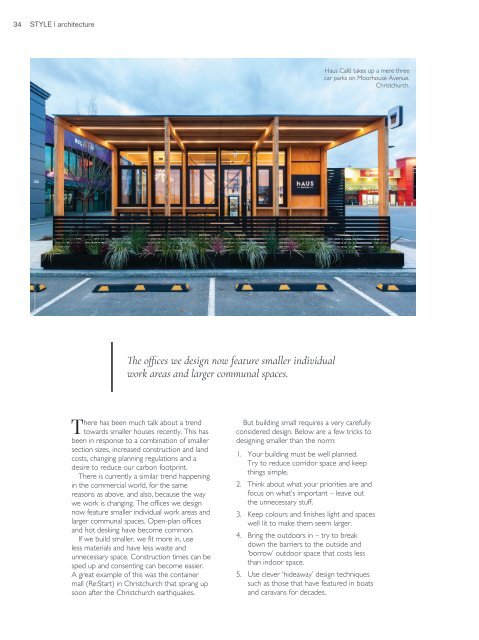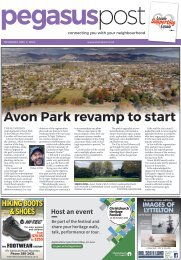Style: November 01, 2019
Create successful ePaper yourself
Turn your PDF publications into a flip-book with our unique Google optimized e-Paper software.
34 STYLE | architecture<br />
Haus Café takes up a mere three<br />
car parks on Moorhouse Avenue,<br />
Christchurch.<br />
Image: Jane Armstrong<br />
The offices we design now feature smaller individual<br />
work areas and larger communal spaces.<br />
There has been much talk about a trend<br />
towards smaller houses recently. This has<br />
been in response to a combination of smaller<br />
section sizes, increased construction and land<br />
costs, changing planning regulations and a<br />
desire to reduce our carbon footprint.<br />
There is currently a similar trend happening<br />
in the commercial world, for the same<br />
reasons as above, and also, because the way<br />
we work is changing. The offices we design<br />
now feature smaller individual work areas and<br />
larger communal spaces. Open-plan offices<br />
and hot desking have become common.<br />
If we build smaller, we fit more in, use<br />
less materials and have less waste and<br />
unnecessary space. Construction times can be<br />
sped up and consenting can become easier.<br />
A great example of this was the container<br />
mall (Re:Start) in Christchurch that sprang up<br />
soon after the Christchurch earthquakes.<br />
But building small requires a very carefully<br />
considered design. Below are a few tricks to<br />
designing smaller than the norm:<br />
1. Your building must be well planned.<br />
Try to reduce corridor space and keep<br />
things simple.<br />
2. Think about what your priorities are and<br />
focus on what’s important – leave out<br />
the unnecessary stuff.<br />
3. Keep colours and finishes light and spaces<br />
well lit to make them seem larger.<br />
4. Bring the outdoors in – try to break<br />
down the barriers to the outside and<br />
‘borrow’ outdoor space that costs less<br />
than indoor space.<br />
5. Use clever ‘hideaway’ design techniques<br />
such as those that have featured in boats<br />
and caravans for decades.


















